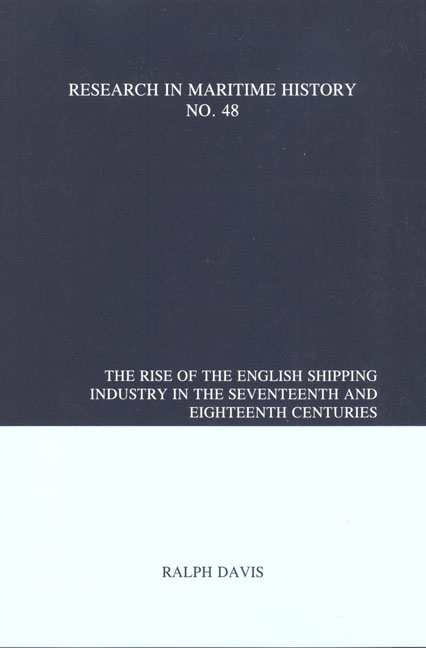Book contents
- Frontmatter
- Contents
- Introduction to the 2012 Edition
- Series Editor's Note
- Introduction
- Preface
- Chapter 1 The Widening of Horizons, 1560-1689
- Chapter 2 Consolidation, 1689-1775
- Chapter 3 Ships and Shipbuilders in the Seventeenth Century
- Chapter 4 Ships and Shipbuilders in the Eighteenth Century
- Chapter 5 The Shipowners
- Chapter 6 The Merchant Seamen
- Chapter 7 The Pay and Conditions of Merchant Seamen
- Chapter 8 Shipping Management and the Role of the Master
- Chapter 9 Shipping and Trade
- Chapter 10 The Nearby and Northern European Trades
- Chapter 11 The Southern European and Mediterranean Trades
- Chapter 12 The East Indian Trade
- Chapter 13 The American and West Indian Trades
- Chapter 14 The Government and the Shipping Industry
- Chapter 15 War and the Shipping Industry
- Chapter 16 Four Ships and Their Fortunes
- Chapter 17 Was It a Profitable Business?
- Chapter 18 Conclusion
- Appendix A A Note on the Shipping Statistics, 1686-1788
- Appendix B Sources for the History of the Shipping Industry
- Index
Appendix A - A Note on the Shipping Statistics, 1686-1788
- Frontmatter
- Contents
- Introduction to the 2012 Edition
- Series Editor's Note
- Introduction
- Preface
- Chapter 1 The Widening of Horizons, 1560-1689
- Chapter 2 Consolidation, 1689-1775
- Chapter 3 Ships and Shipbuilders in the Seventeenth Century
- Chapter 4 Ships and Shipbuilders in the Eighteenth Century
- Chapter 5 The Shipowners
- Chapter 6 The Merchant Seamen
- Chapter 7 The Pay and Conditions of Merchant Seamen
- Chapter 8 Shipping Management and the Role of the Master
- Chapter 9 Shipping and Trade
- Chapter 10 The Nearby and Northern European Trades
- Chapter 11 The Southern European and Mediterranean Trades
- Chapter 12 The East Indian Trade
- Chapter 13 The American and West Indian Trades
- Chapter 14 The Government and the Shipping Industry
- Chapter 15 War and the Shipping Industry
- Chapter 16 Four Ships and Their Fortunes
- Chapter 17 Was It a Profitable Business?
- Chapter 18 Conclusion
- Appendix A A Note on the Shipping Statistics, 1686-1788
- Appendix B Sources for the History of the Shipping Industry
- Index
Summary
The pathway through the shipping statistics of the seventeenth and eighteenth centuries is a slippery and often misleading one. Several writers have attempted to follow it; in 1915 Walther Vogel, “Zur Grosse der europaischen Handelsflotten im 15, 16 and 17 Jahrhundert;” fourteen years later A.P. Usher, “The Growth of English Shipping, 1572-1922;” and in 1939 L.A. Harper, who devoted nearly a third of a large book to a most thorough investigation. I myself spent much time gathering basic data and manipulating them; the results are in my unpublished London PhD thesis. The figures used here differ significantly from those developed in the above works (including the last). No doubt they will not escape revision in due time; but I hope future revisions will not be so drastic as to destroy the general picture of growth, slowing down and new growth which is presented here.
There are three potential sources of error in the preparation of comparative shipping statistics for this period.
(i) Errors in the original recording of or counting the number of ships. Nothing can be done about this; there is no reason to suppose it has much importance, though the existence of a smuggling fleet in the eighteenth century should be borne in mind.
(ii) Inconsistencies in contemporary recording of the tonnage of individual ships. This is much less important than many writers have supposed; almost invariably recorded tonnages are tons burden. Though, an individual ship may be put down at different times at several different tonnages, over a great mass of material these differences should be evened out; there is no reason to think that there were consistent errors in one direction followed at a later period by consistent errors in another. Two exceptions must be mentioned, however. One is the practice of recording the tonnage of East Indiamen, from the early years of the eighteenth century onward, at 499 tons or less, though many of them were far larger. This I shall remark again later. The other is the growth after 1773 of the practice of recording measured tons rather than tons burden; of no importance in the period we are specifically concerned with, it makes comparisons with later dates very difficult - especially as measured tonnage came to be used invariably in records after general registration began in 1786.
- Type
- Chapter
- Information
- The Rise of the English Shipping Industry in the Seventeenth and Eighteenth Centuries , pp. 379 - 390Publisher: Liverpool University PressPrint publication year: 2012

